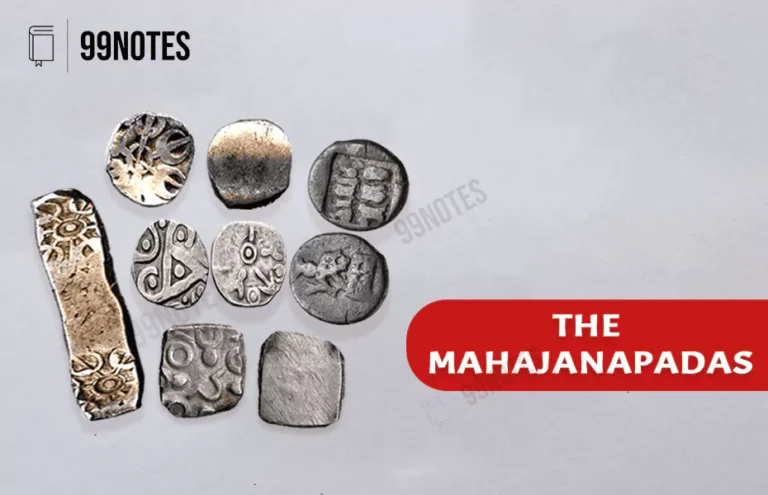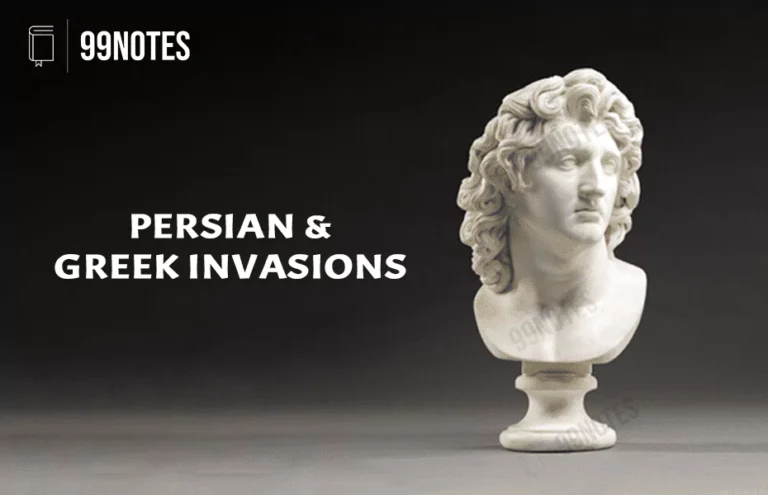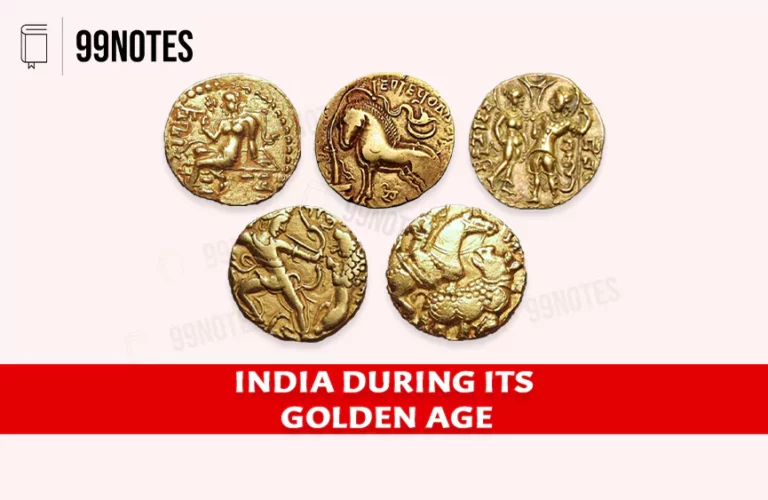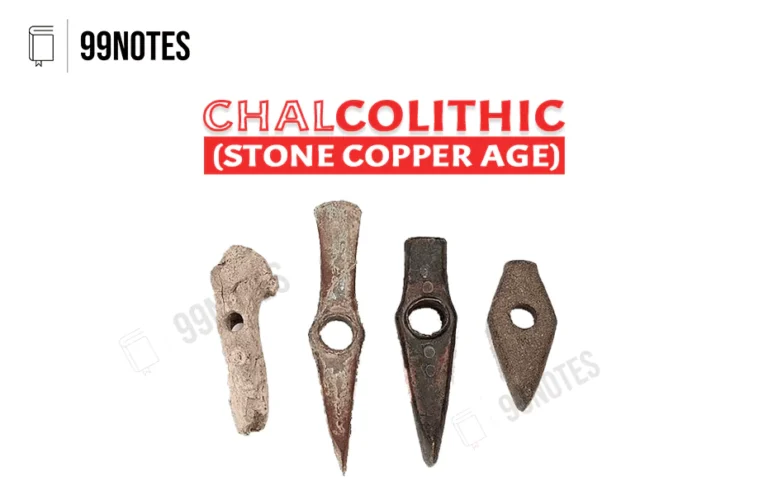Various aspects of Harappan Civilisation
Town Planning
Harappan civilisation features very impressive and very well-planned structures of the towns.
- Settlement pattern– The whole town was divided into two parts – Citadel and a lower town.
- Citadel was built higher than the lower town and could have housed the important people in the city – wealthy traders, rulers and priests. In comparison, the lower town housed ordinary people.
- Both parts of the town were built on a raised platform. The whole city was fortified with burnt brick walls.
(Source 12th NCERT: Themes in World History)
- Roads-
- Roads were in a grid-like pattern crisscrossing each other at 90 degrees.
- There was often a provision of a street light at the crossings.
- Houses were built in a grid pattern on either side of the roads.
- The roads were wide, having a drain on their side.
- Houses –
- People used burnt bricks to build houses with a fixed proportion of 4:2:1 (Length: width: Height).
- Each house had a drawing room, bedroom, kitchen, a spacious veranda, a bathroom and a well nearby.
- Houses were provided with doors & small windows, and a high compound wall.
- Wastewater was drained out into the main drain of the town.
- Evidence of more than one-storied building has been found.
A typical house in Mohenjodaro
(Source 12th NCERT: Themes in World History)
- Drainage pattern-
- The kitchen and bathroom had drains leading out of each house which was connected to the big drain outside the house.
- Drains were provided on either side of the roads, lined with burnt bricks and covered on the top. Inspection holes were provided for regular cleaning. These drains generally terminated in a big well outside the city.
- Granaries –
- Cities generally had brick structures used for storing grains, built on a massive brick foundation and a raised platform to prevent it from flooding.
- It generally was the largest building in the town. In Harappa, it consisted of two rows of six rooms with a central passageway. Lothal and Mohenjodaro, too, had large granaries.
- Had platforms for the thrashing of crops and rooms for housing labour.
Society
Various discoveries from the sites throw light on the social structure of the Harappan society –
- No evidence of imperialism: The power gap between the oligarchs and the commoners cannot be too huge as we cannot find any evidence of dynastic politics or larger-than-life kings. Unlike the other ancient civilisations of the world, the Harappan civilisation showed remarkable equality.
- Two levels in towns – The discovery of the citadel and lower town suggest that there were two classes of people in Harappan society – the oligarchy (group of rulers, wealthy merchants or priests) and the working class. Important buildings like citadels and granaries existed in the upper part of the town.
- Joint Family: Multiple rooms suggest a Joint family being common.
- Different construction techniques for ‘elite’ Buildings – Harappans had three tiers of habitation — ‘common settlements’ with mud brick walls, ‘elite settlements’ with burnt brick walls alongside mud brick walls, and possible ‘middle-rung settlements.
- High level of standardisation – The presence of seals, standardisation of artefacts, and use of uniform weights hints toward the existence of a central authority regulating various economic activities.
- The difference in Burial pattern – Some burials had hollowed-out spaces within the burial chamber, lined with bricks and had luxury items buried along with them, while many burials were simple.
- Equality between men and women – Jewellery was found buried with the dead in the burials of both men and women, which indicated equality between men and women.
- The difference in artefacts – The discovery of rare and common artefacts suggests two class types of people were using them.
- Objects of daily use –
- Made of ordinary materials, stone & clay, found distributed throughout the settlement.
- It included querns, pottery, needles, flesh rubbers etc.
- The copper and bronze ware included tools, weapons, ornaments and vessels.
- Luxury Items – are either rare or made from costly, non-local materials or with complicated technologies.
- Lapiz Lazuli(blue stone from Afghanistan) contributed to the social prestige of the ruling class.
- Such items are distributed well in large sites such as Mohenjo-Daro and Harappa but were rarely found in smaller settlements such as Kalibangan.
- Gold was rare and was probably precious – all the gold jewellery found at Harappan sites was recovered from hoards.
- Objects of daily use –
Religion
- A predominantly secular society: Although we have found some religious symbols, such as the Pashupati seal and Mother Goddess, these don’t point to a predominantly religious society. This is because we have not found elaborate religious structures such as temples as those found in Egypt or Mesopotamia.
- No temples: Not many buildings in the Indus valley can be attributed to temple worship or dedicated to ritualism. However, structures like ‘the Great bath’ of Mohenjo-Daro could have been used for religious purposes. Despite this, few theories on deity worship have been developed.
- The Proto Shiva theory: John Marshall put forward the first study of the religion of the Harappan civilisation.
- In the ‘Pashupati Seal’, there is a man with two large horns. The animals surrounding him are similar to the Pashupati form of Shiva. John Marshall considered it as an early form of Shiva called mahayogi.
- Some cylindrical stones similar to Shiva Linga were also found in Mohenjo-Daro and Harappa.
- Mother goddess:
- Among several female figurines discovered at Mohenjo-Daro and Harappa, Marshall pointed out the One with a fan-shaped headdress, wearing a bead necklace and short skirt to be a mother goddess. She represents the mother or nature goddess.
- There is a terracotta figure from Harappa; a plant is shown out of the womb representing the fertility power of the goddess.
- This suggests that the mother-goddess cult was prevalent in a few areas.
- Phallus worship: There is evidence of phallus worship in the Indus valley civilisation as evident by the discovery of Male Yoni in several places like Harappa.
- Fire Altars: The discovery of fire altars in a few places suggests the existence of a sacrificial ritual in the Harappan cultures.
- The sacredness of Pipal trees: One seal depicts seven figures paying obeisance to the pipal tree. A horned figure stands on the tree. Some scholars argue that this scene is reminiscent of later-day Saptmatrikas (a group of seven mother-goddesses). Some even identify the figures as sapt-rishis.
Source: https://www.harappa.com/blog/unicorn-and-pipal-tree-seal#:~:text=A%20seal%20from%20Mohenjo%2Ddaro,the%20so%2Dcalled%20unicorn.%22
- Burials: Burials show a great deal of difference in different sites of the Harappa. The dead were buried with pottery, ornaments and other artefacts, indicating a belief in the existence of an afterlife.
- Mohenjo-Daro – has burials within the settlement.
- Harappa, Kalibangan, Lothal, Dholavira and Rakhigarhi had separate cemeteries.
- Dholavira – has some evidence of megaliths, but these are mostly symbolic burials.
- Rakhigarhi- in the cemetery, the female burials often had more burial goods than the male burials.
Arts
Seals
- A seal works as a mark or a stamp. Harappans used to press a seal against wet clay to create a unique clay tablet, which could be used as a signature. This is how a seal works.
- Usage– They were mainly used as a unit of trade and commerce, as an amulet (to ward off evil) and also as an educational tool (presence of a pie sign).
- Shape and size: a standard Harappan seal was 2×2 square inches.
- Materials: generally made from soft river stone and steatite.
- Engravings: Each seal has a pictographic script along with animal impressions which are yet to be deciphered, written from right to left. Scholars believe that it might contain the name of the sender.
- For example– the Pashupati Mahadev seal is made of steatite (Mahayogi Seal or the Proto-Siva Seal) found in Mohenjo-Daro. It depicts three-faced gods with buffalo horns sitting cross-legged on a throne surrounded by an elephant, a tiger in his right and a rhinoceros, buffalo in his left and two deer at his feet.
Sculptures:
- We find sculptures made of a variety of materials by the Harappans. These include bronze, copper, stone, and terracotta.
- Bronze sculptures are manufactured through the lost wax technique– Under this technique, at first, a wax figure is sculpted. Then it is covered with a coat of clay. Once the clay is dry, the whole assembly is heated, allowing the wax to melt and drain through a hole. This leaves the clay mould hollow, which is then filled with molten bronze. Once the metal solidifies upon cooling, the clay mould is removed, revealing the bronze sculpture similar to the initial wax figure.
- Some major sculptures:
| Sculptures and their Features | |
| Dancing girl from Mohenjo-Daro (2500BCE) Material: Bronze – using the lost wax techniqueA thin young woman in Tribhanga posture with large eyes, curly hair, a flat nose, arms unnaturally long and wearing only a necklace alongside some bangles.Her right hand rested on her hip, and her left hand rested on her left thigh.Hairs plaited and neatly tied in a bunHead tilted slightly backwardsThe number of bangles in her hands differs. | |
| Bearded Priest King from Mohenjodaro Material: steatiteA bearded man wears a shawl worn over his left shoulder. It goes under the right arm.He wears something like an amulet on the arm right arm. | |
| Bronze bull from Mohenjodaro Material: bronzeStanding with his head turned rightHas a cord around his neck | |
| Male Torso from Harappa Material: Red sandstoneOnly the torso portion survives today.The empty socket holes in the neck and shoulders suggest that it had a head and arms too.Legs are broken, and the shoulders are well bakedThe abdomen is slightly prominent | |
| Mother Goddess Found in many sites such as Mohenjo-Daro, Harappa, KalibanganMaterial: TerracottaHas variation across and within sitesIn one figurine from Harappa, a plant is shown out of the embryo.A few versions have been found with pot-bellied or have a child in her arms. |
Pottery:
- The Indus Valley pottery consists chiefly of very fine wheel-made wares, very few being hand-made. Different types of potteries are: –
| Plain pottery It generally consists of red clay. It can also have a fine red or grey slip. A few pots are ornamented with rows of knobs (Knobware). It is more common than painted ware. | |
| Polychrome pottery It mainly comprises small vases decorated with geometric patterns. It uses red, black, and green colours and rarely white and yellow are used. Ochre was used to produce red colour for paintings. | |
| Black and red painted ware It is a characteristic black colour manufactured by combining dark reddish-brown iron oxide with black manganese. Animal and geometric designs are executed in glossy black paint on the fine coating of red slip. | |
| Incised ware The incised decoration on such pottery is confined to the pans’ bases and the offering stands’ dishes.Example: Dancing girl incised on a potshread in Birhana | |
| Perforated pottery It includes a large number of holes small holes all over the wall and a large home at the bottom. It was probably used for straining beverages. |
Beads
- Made from- cornelian, amethyst, steatite, turquoise etc.
- Shapes – disc-shaped, cylindrical, spherical, barrel-shaped and segmented.
- Factories were discovered at Chanhudaro and Lothal.
Source: https://www.harappa.com/content/bead-technologies-harappa-3300-1900-bce-comparative-summary
Ornaments:
- The Harappans used ornaments from various materials – precious metals, gemstones, bone and even baked clay.
- Necklaces, armlets and finger rings were common and worn by both males and females.
- Women often wore girdles, earrings and anklets.
- Evidence of dead bodies buried along with ornaments has also been found.
- Harappans were conscious of fashion too. We find evidence of different hairstyles, wearing of a beard etc. Cinnabar was used as a cosmetic; face paint, lipstick and even eyeliners were all known.
Economy
The Harappan landscape consisting of alluvial plains, mountains, plateau, and sea coasts, was rich enough to generate a surplus for trade. Occupations varied from farming, weaving, pottery, metal works, toy making, jewellery, stone cutting & trading.
· Agriculture
- They grew two crops yearly, but Rabi or winter crops seem to be the dominant practice. They grew wheat, barley, pea, chickpea, sesame, mustard and lentil in winters.
- Kharif crops grown were rice and millet. They were probably one of the first to grow paddy in the world.
- The Harappan farmers were the first people to spin and weave cotton. At Mohenjo-Daro, archaeologists discovered pieces of cotton textiles dating from between 3250 and 2750 BCE in 1929. In the nearby Mehrgarh site, cottonseeds have been found dating to 5000 BCE.
- The technology used – We have found a terracotta plough model from Banawali and Bahawalpur and ploughed field at Kalibangan. In addition, copper sickles have been found in various places.
- Irrigation – We find sheet-floodingin Sindh, canal irrigation for Ghaggar-Hakra, and usage of reservoirs in Dholavira.
Source: https://www.harappa.com/slide/reservoir-dholavira
Animal husbandry
- Animals domesticated were cattle, buffalo, sheep, goat, pig, camel, elephant, dog, cat, ass and others.
- The Harappans weren’t familiar with the horse much. Only a few horse-like bones have been found in Surkotada alone (Gujarat – 2000 BC).
- Animals that were hunted include wild buffalo, deer, wild pig, ass, jackal, rodents and hare. In addition, bones of wild animal species such as boar, deer & gharial are also found.
- Fishing and hunting prevailed during this time, as evident by the use of fishing hooks even in places like Banawali (Haryana), where fish is not a part of the diet today.
Industry
- Metallurgy: Harappans were aware of copper, gold and silver. For example- Sixteen copper furnaces have been found at Lothal.
- Copper occurs in the form of weapons, agricultural tools like sickles, carpentry tools like chisels, ornaments like kohl sticks, earrings and other objects like fish hooks, needles and scale pans.
- They knew techniques like forging, sinking, and hot and cold welding.
- All sites have gold & silver earrings and sewing needles.
- Bead Making:
- Materials used: Jasper, crystal, quartz, steatite (a very soft stone) and carnelian (red colour was obtained by firing yellowish raw material & beads at various stages of production);
- Some beads were made up of two or more stones cemented together; some had gold caps; some were decorated by incising or painting, and some had designs etched onto them.
- Different shapes – cylindrical, spherical, barrel-shaped, segmented
- Process – Grinding, polishing & drilling completed the process. Some specialised drills were found in Chanhudaro, Lothal & more recently at Dholavira.
- Spinning and weaving: Woollen clothes were manufactured from sheep and goats’ hair.
- Toy Making: manufacture of the terracotta figurine was one of the major industries.
Weights and Measures
- They used scales made of shell, ivory, and copper for linear measurement, as discovered in Mohenjodaro, Lothal and Harappa.
- Measuring weights:
- They used a precise system of weights and measures.
- Lower denominations of weights used binary measurements (1 to 64 multiples of 0.871 grams); used probably for weighing jewellery & beads.
- Higher denominations followed the decimal system.
- Most weights were cubical, made up of chert, and few were made of jasper and agate.
- Metal scale pans were also found in many places.
Trade
Major Trade centres and their products:
| Trade Centres | Exports and specialised crafts |
| Nageshwar & Balakot | Shell objects – including bangles, ladles & inlay – were taken to other settlements near the coast. |
| Chanhudaro & Lothal | Fine Metalworks and seals were taken to large centres such as Mohanjodaro & Harappa. |
| Harappa | Boatmaking |
| Sukkur-Rohri hills | Chert blades |
| Baluchistan | Copper, lead, jasper, agate & shilajit traded via south Sindh |
| Sindh | Shell and flint supplied to Punjab |
| Rajasthan | Gold, silver, lead, semi-precious stones and copper (Khetri region); It imported shell and chert. |
| Hills near Punjab | Steatite, gypsum, jasper, limestone, slate, granite, basalt, marble, quartzite, sandstone, abri, copper, lead, gold and haematite |
Primary Sources of Raw material for Harappans
| Suppliers | Items Imported |
| South India | Gold |
| Afghanistan | Gold, silver & Lapis lazuli |
| Oman | Copper |
| Persia | Beads |
Trade with the west
- Mesopotamian texts mention contacts with regions name Dilmun (Bahrain possibly), Magan (Makran coast) & Meluha (Harappan region possibly). Products imported from Meluha were copper, tin, lapis lazuli, carnelian, ebony, gold, silver, ivory, beads, Mulberry wood and date palm.
- There were many similarities with Mesopotamia: Burnt-baked dried bricks were used in Harappa, Mesopotamia and Egypt. Harappans also imitated some cosmetics used by urban people of Mesopotamia.
- Carnelian beads were exported to Iran.
- Despite various studies on the impurities found in the Tin in Indus Valley, the tin source is unknown to this date.
Transport
- They knew the use of the wheel; for example, charts with solid wheels were in use.
- They used some kind of modern ekka but not a spoked wheel.
- Boats – Mesopotamian texts refer to Meluha (Harappans culture) as the land of Seafarers, and Harappans practised boatmaking.
Script
- Written Harappan scripts were found in some steatite seals containing animal motifs and signs. It remains un-deciphered.
- The Seals found in Indus Valley usually have a line of writing on the top. Scholars believe that it can be the name and title of the owner.
- Most inscriptions are short, and longer ones contain some 26 signs.
- The Indus script was not alphabetical but pictographic. It had too many signs, around 375-400.
- It was written from right to left. This is evident because some seals show wider spacing on the right and cramping on the left.
- Writing is found on seals, copper tools, rims of jars, copper & terracotta tablets, jewellery, bone rods, and even ancient signboard (Lothal).
Source: https://www.ancient-asia-journal.com/articles/10.5334/aa.12317/print/
Conclusion:
Harappan civilisation was a masterpiece of urban culture, with a degree of planning which couldn’t be achieved for 1000s of years in the future. It was far more advanced than all of its contemporary civilisations in terms of town planning, the focus on sanitation and organisation. This is highly remarkable given that we do not find the mention of any strong centre or any king.
As mysterious as its origin and its organisation, similar in its decline.



![Mauryan Empire (321-185 Bce): Rulers, Map, &Amp; Administration [Complete Notes For Upsc Exams] | Updated July 27, 2024 Mauryan Empire (321-185 Bce): Rulers, Map, &Amp; Administration [Complete Notes For Upsc Exams]](https://99notes.in/wp-content/uploads/2023/04/mauryan-empire-99notes-upsc-1-768x495.webp)



